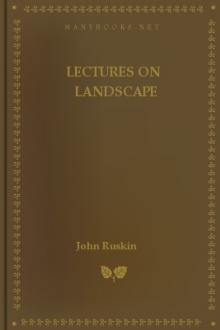The Crown of Wild Olive by John Ruskin (a court of thorns and roses ebook free .TXT) 📕

- Author: John Ruskin
- Performer: -
Book online «The Crown of Wild Olive by John Ruskin (a court of thorns and roses ebook free .TXT) 📕». Author John Ruskin
182. And observe, these Athenian and Florentine schools are both of equal rank, as essentially original and independent. The Florentine, being subsequent to the Greek, borrowed much from it; but it would have existed just as strongly—and, perhaps, in some respects, more nobly—had it been the first, instead of the latter of the two. The task set to each of these mightiest of the nations was, indeed, practically the same, and as hard to the one as to the other. The Greeks found Phœnician and Etruscan art monstrous, and had to make them human. The Italians found Byzantine and Norman art monstrous, and had to make them human. The original power in the one case is easily traced; in the other it has partly to be unmasked, because the change at Florence was, in many points, suggested and stimulated by the former school. But we mistake in supposing that Athens taught Florence the laws of design; she taught her, in reality, only the duty of truth.
183. You remember that I told you the highest art could do no more than rightly represent the human form. This is the simple test, then, of a perfect school,—that it has represented the human form, so that it is impossible to conceive of its being better done. And that, I repeat, has been accomplished twice only: once in Athens, once in Florence. And so narrow is the excellence even of these two exclusive schools, that it cannot be said of either of them that they represented the entire human form. The Greeks perfectly drew, and perfectly moulded the body and limbs; but there is, so far as I am aware, no instance of their representing the face as well as any great Italian. On the other hand, the Italian painted and carved the face insuperably; but I believe there is no instance of his having perfectly represented the body, which, by command of his religion, it became his pride to despise, and his safety to mortify.
184. The general course of your study here renders it desirable that you should be accurately acquainted with the leading principles of Greek sculpture; but I cannot lay these before you without giving undue prominence to some of the special merits of that school, unless I previously indicate the relation it holds to the more advanced, though less disciplined, excellence of Christian art.
In this and the last lecture of the present course,[135] I shall endeavour, therefore, to mass for you, in such rude and diagram-like outline as may be possible or intelligible, the main characteristics of the two schools, completing and correcting the details of comparison afterwards; and not answering, observe, at present, for any generalization I give you, except as a ground for subsequent closer and more qualified statements.
And in carrying out this parallel, I shall speak indifferently of works of sculpture, and of the modes of painting which propose to themselves the same objects as sculpture. And this indeed Florentine, as opposed to Venetian, painting, and that of Athens in the fifth century, nearly always did.
185. I begin, therefore, by comparing two designs of the simplest kind—engravings, or, at least, linear drawings, both; one on clay, one on copper, made in the central periods of each style, and representing the same goddess—Aphrodite. They are now set beside each other in your Rudimentary Series. The first is from a patera lately found at Camirus, authoritatively assigned by Mr. Newton, in his recent catalogue, to the best period of Greek art. The second is from one of the series of engravings executed, probably, by Baccio Baldini, in 1485, out of which I chose your first practical exercise—the Sceptre of Apollo. I cannot, however, make the comparison accurate in all respects, for I am obliged to set the restricted type of the Aphrodite Urania of the Greeks beside the universal Deity conceived by the Italian as governing the air, earth, and sea; nevertheless the restriction in the mind of the Greek, and expatiation in that of the Florentine, are both characteristic. The Greek Venus Urania is flying in heaven, her power over the waters symbolized by her being borne by a swan, and her power over the earth by a single flower in her right hand; but the Italian Aphrodite is rising out of the actual sea, and only half risen: her limbs are still in the sea, her merely animal strength filling the waters with their life; but her body to the loins is in the sunshine, her face raised to the sky; her hand is about to lay a garland of flowers on the earth.
186. The Venus Urania of the Greeks, in her relation to men, has power only over lawful and domestic love; therefore, she is fully dressed, and not only quite dressed, but most daintily and trimly: her feet delicately sandalled, her gown spotted with little stars, her hair brushed exquisitely smooth at the top of her head, trickling in minute waves down her forehead; and though, because there's such a quantity of it, she can't possibly help having a chignon, look how tightly she has fastened it in with her broad fillet. Of course she is married, so she must wear a cap with pretty minute pendant jewels at the border; and a very small necklace, all that her husband can properly afford, just enough to go closely round the neck, and no more. On the contrary, the Aphrodite of the Italian, being universal love, is pure-naked; and her long hair is thrown wild to the wind and sea.
These primal differences in the symbolism, observe, are only because the artists are thinking of separate powers: they do not necessarily involve any national distinction in feeling. But the differences I have next to indicate are essential, and characterize the two opposed national modes of mind.
187. First, and chiefly. The Greek Aphrodite is a very pretty person, and the Italian a decidedly plain one. That is because a Greek thought no one could possibly love any but pretty people; but an Italian thought that love could give dignity to the meanest form that it inhabited, and light to the poorest that it looked upon. So his Aphrodite will not condescend to be pretty.
188. Secondly. In the Greek Venus the breasts are broad and full, though perfectly severe in their almost conical profile;—(you are allowed on purpose to see the outline of the right breast, under the chiton:)—also the right arm is left bare, and you can just see the contour of the front of the right limb and knee; both arm and limb pure and firm, but lovely. The plant she holds in her hand is a branching and flowering one, the seed vessel prominent. These signs all mean that her essential function is child-bearing.
On the contrary, in the Italian Venus the breasts are so small as to be scarcely traceable; the body strong, and almost masculine in its angles; the arms meagre and unattractive, and she lays a decorative garland of flowers on the earth. These signs mean that the Italian thought of love as the strength of an eternal spirit, for ever helpful; and for ever crowned with flowers, that neither know seed-time nor harvest, and bloom where there is neither death, nor birth.
189. Thirdly. The Greek Aphrodite is entirely calm, and looks straight forward. Not one feature of her face is disturbed, or seems ever to have been subject to emotion. The Italian Aphrodite looks up, her face all quivering and burning with passion and wasting anxiety. The Greek one is quiet, self-possessed, and self-satisfied; the Italian incapable of rest, she has had no thought nor care for herself; her hair has been bound by a fillet like the Greeks; but it is now all fallen loose, and clotted with the sea, or clinging to her body; only the front tress of it is caught by the breeze from her raised forehead, and lifted, in the place where the tongues of fire rest on the brows, in the early Christian pictures of Pentecost, and the waving fires abide upon the heads of Angelico's seraphim.
190. There are almost endless points of interest, great and small, to be noted in these differences of treatment. This binding of the hair by the single fillet marks the straight course of one great system of art method, from that Greek head which I showed you on the archaic coin of the seventh century before Christ, to this of the fifteenth of our own era—nay, when you look close, you will see the entire action of the head depends on one lock of hair falling back from the ear, which it does in compliance with the old Greek observance of its being bent there by the pressure of the helmet. That rippling of it down her shoulders comes from the Athena of Corinth; the raising of it on her forehead, from the knot of the hair of Diana, changed into the vestal fire of the angels. But chiefly, the calmness of the features in the one face, and their anxiety in the other, indicate first, indeed, the characteristic difference in every conception of the schools, the Greek never representing expression, the Italian primarily seeking it; but far more, mark for us here the utter change in the conception of love; from the tranquil guide and queen of a happy terrestrial domestic life, accepting its immediate pleasures and natural duties, to the agonizing hope of an infinite good, and the ever mingled joy and terror of a love divine in jealousy, crying, "Set me as a seal upon thine heart, as a seal upon thine arm; for love is strong as death, jealousy is cruel as the grave."
The vast issues dependent on this change in the conception of the ruling passion of the human soul, I will endeavour to show you, on a future occasion: in my present lecture, I shall limit myself to the definition of the temper of Greek sculpture, and of its distinctions from Florentine in the treatment of any subject whatever, be it love or hatred, hope or despair.
These great differences are mainly the following.
191. 1. A Greek never expresses momentary passion; a Florentine looks to momentary passion as the ultimate object of his skill.
When you are next in London, look carefully in the British Museum at the casts from the statues in the pediment of the Temple of Minerva at Ægina. You have there Greek work of definite date;—about 600 b.c., certainly before 580—of the purest kind; and you have the representation of a noble ideal subject, the combats of the Æacidæ at Troy, with Athena herself looking on. But there is no attempt whatever to represent expression in the features, none to give complexity of action or gesture; there is no struggling, no anxiety, no visible temporary exertion of muscles. There are fallen figures, one pulling a lance out of his wound, and others in attitudes of attack and defence; several kneeling to draw their bows. But all inflict and suffer, conquer or expire, with the same smile.
192. Plate XIV. gives you examples, from more advanced art, of true Greek representation; the subjects being the two contests of leading import to the Greek heart—that of Apollo with the Python, and of Hercules with the Nemean Lion. You see that in neither case is there the slightest effort to represent the λυσσα or agony of contest. No good Greek artist would have you behold the suffering, either of gods, heroes, or men; nor allow you to be apprehensive of the issue of their contest with evil





Comments (0)